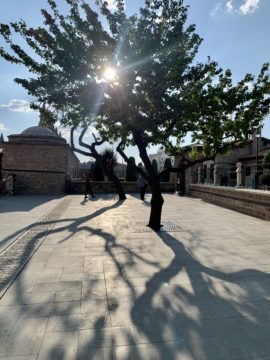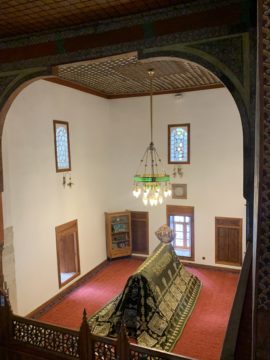by Shadab Zeest Hashmi
 A tree in the vicinity of Rumi’s tomb has me transfixed. It isn’t the tree, actually, it is the force of attraction between tree-branch and sun-ray that seems to lift the tree off the ground and swirl it in sunshine, casting filigreed shadows on the concrete tiles across the courtyard. The tree’s heavenward reach is so magnificent that not only does it seem to clasp the sun but it spreads a tranquil yet powerful energy far beyond itself. It is easy to forget that the tree is small. I consider this my first meeting with Shams.
A tree in the vicinity of Rumi’s tomb has me transfixed. It isn’t the tree, actually, it is the force of attraction between tree-branch and sun-ray that seems to lift the tree off the ground and swirl it in sunshine, casting filigreed shadows on the concrete tiles across the courtyard. The tree’s heavenward reach is so magnificent that not only does it seem to clasp the sun but it spreads a tranquil yet powerful energy far beyond itself. It is easy to forget that the tree is small. I consider this my first meeting with Shams.
Of average human-height, the tree is non-descript, other than how its heavenward reaching creates an embrace that enricles and enlarges everything around it, so that motion ripples out of stillness, light edges shadows. In a moment such as this, the senses deepen spirit; words fail, words fail. All that we know evaporates, we are left with spirit. Here is the limit of knowledge, the Sufis teach us; no amount of book learning alone can bring us closer to the Divine than the spirit engaged in making a wide embrace. The Divine is an experience, and knowledge is only a part of it. If there is one word that comes close to describing this, it is love. But of course, the word is insufficient. No single word in conventional language can contain love. Poetry, arguably, owes its existence to the impossibility of defining love in the dictionary. In Maulana Rumi’s case, it was Shams who brought this awakening, this great desire for the Divine beloved that colored every thought, action and word that was to come out of him in the future.
The disruption that Shams caused in Rumi’s life became a legend. Shams appeared as if out of nowhere, challenged the limits of Rumi’s mind and the untapped potential of his soul. The only way to true spiritual maturity, he taught Rumi, is through the heart: a heart that is “broken open.” Within a matter of days, some say 40, Rumi was transformed from the persona of an established scholar, a well-respected teacher, to an ecstatic poet, one to whom a door was suddenly opened and who was blinded and overjoyed by the light that came through. This, for Shams, was not enough; their spiritual synergy, a great blessing as it was, was insufficient yet for Rumi to reach the next level; separation was a necessity. According to William C. Chittick, in Me and Rumi: The “autobiography” of Shams-i-Tabrizi, derived from written conversations between Shams and Rumi: “On more than one occasion he (Shams) implies that it would be best for him to leave, because Rumi was not yet mature enough to take full benefit from him. He says, for example, that he went to Aleppo because Rumi needed to be cooked by separation (3.220). When he did return, the fruit of separation was clear, because Rumi took much benefit from him: “One day of his companionship is equal to a year of that (earlier) companionship” (3.223). Rumi may be alluding to the role of Shams in a famous line that is often attributed to him by scholars of Persian: “The fruit of my life is no more than three words—I was raw, I was cooked, I was burnt.” Perhaps Shams left because Rumi was now cooked and needed to be burned. Suddenly it was not a coincidence that Rumi was now forty, the traditional age of spiritual maturity.”
Love traverses the domains of the heart, mind, spirit and the body. To Sufis such as Shams, understanding the Qura’an and prophetic tradition in the truest sense, is to understand all the ways how this great tradition is a language of love, a highly complex, dynamic, multifaceted force with mercy at its core, “Ar-Rahaman” (“The Supremely Merciful One”) being one of the foremost names for God. Shams himself had had no shortage of book learning, but he considered it only a basic step. Chittick says, “The stories and anecdotes told in the later literature often make Shams out to be a spiritual genius, contemptuous of book learning and ignorant of the Islamic sciences. The discourses show that there is little basis for this view. In fact, Shams knew the Quran by heart and used to make his living as a teacher. He had studied jurisprudence (fiqh)—the science of the Shariah, the religious law—and even in Konya he spent time in the company of jurists. He certainly looked with contempt on superficial learning and the pretentions of the Ulamah.”
At first Shams destabilized Rumi by openly challenging his scholastic approach to faith, calling out his complacency as a theologian. Perhaps the greatest teaching Shams brought to Rumi was an appreciation of paradox— a philosophical and spiritual level one can arrive at after a deep reading of sacred literature and immersing in meditation. Paradox (especially as reflected in Al Asma ul Husna or “The Beautiful Names of God”), balanced with praise, is the hallmark of Sufi wisdom. Rumi blossomed as a mystic poet as he became more and more aware of paradox, sharing with Shams words and silences, attachment and separation. Paradox was to become one of the most dynamic elements of Rumi’s poetry.
Why exactly Shams arrived in Konya, why he would repeatedly disappear and eventually how he disappeared for good, his body never to be found for certain– will remain a mystery. What is clear is that he played a major role in leading to enlightenment one of the most remarkable mystic poets the world has known.

Shams’s grave in Konya, nominated to be a UNESCO world heritage site, is in a beautiful mosque. But of course no one knows if he’s really buried there. In Chittick’s opinion, “A rather late report says that he was murdered by jealous disciples with the collusion of Rumi’s son Ala’aDin, from whom Rumi seems to have been estranged (at least after the departure of Shams). Those who follow this theory locate his tomb in Konya, not far from the tomb of Rumi himself. Others claim that he died in 1273, and that for centuries his tomb was known in Khuy in Iran. There are also tombs attributed to him in other parts of the Islamic world, thus reinforcing his mythic stature. Lewis has argued convincingly that nowhere near enough evidence exists to suggest that Shams was in fact murdered.”
The tree in Maulana Rumi’s tomb/Museum complex strikes me as a dervish— arms raised to the heavens in ecstasy— mirroring the essence of Shams, showing how to integrate the mind, body, and spirit via the paradoxically “vulnerable-powerful” heart, the part of us that has to be broken open for ultimate enlightenment. As I walk through the mosque structure where Shams is said to be resting, I feel a beautiful peace settle within. It is midday, a partly cloudy summer day. The mosque has an abundunce of lovely wooden windows and chandeliers that look like bouquets of white tulips. The aesthetics are a subtle reflection of the cultural crossroads that this place once was— the seat of the Seljuk empire, and the before that, Byzantium.
The thing that really captures my imagination, is a grandfather clock, in fact multiple western-style clocks with pendulums in the mosque, reminiscent perhaps of modern Ottoman sensibility. The rhythm of the pendulum’s sound and motion is a continuum of sorts, subdued five times a day by the “Azaan” or call to prayer; this locking in and freeing time is strangely an apt metaphor for Shams and Rumi. The time that they found together in the pursuit of the sacred, the time that stirred envy and suspicion in many, created controversies and ultimately was a source of maturity for Rumi– was actually brief, only a few months in all, but ironically contributed to our understanding of eternity through Rumi’s verse.
The wood carvings are not too ornate, but embellished enough for the visitor to appreciate the light entering through the various sources. Shams means “the Sun” in Arabic. Readers of Rumi know how well he applied the sage’s name as a metaphor for light. His full name was Shamsuddin Mohamad Tabrizi. “Din” means “chosen path” or “religion.” Shamsuddin stands for “the light of the way.”
Shams’s main message is that Love is its own language, the finest one to understand and speak of God with— superior by far to the languages that the intellect can conjure, echoed by Rumi in his famous lines: “Trying to explain Love, the intellect fell down in the mud like an ass— Love and loverhood can only be explained by Love. The sun is the sun’s proof; If you must have proof, then turn not your face away from it.”
